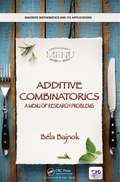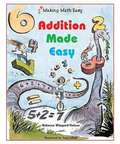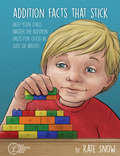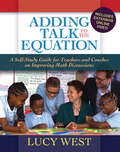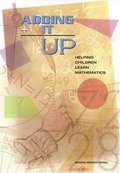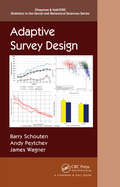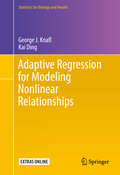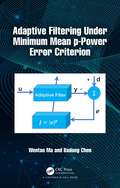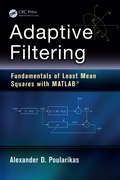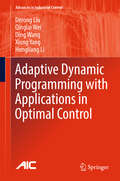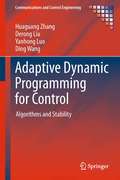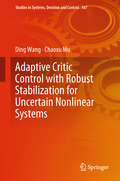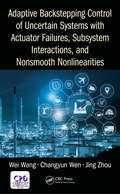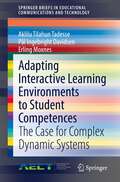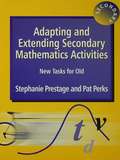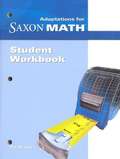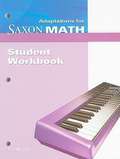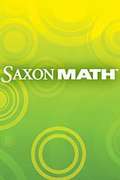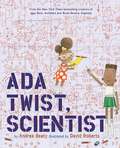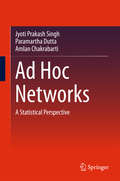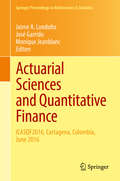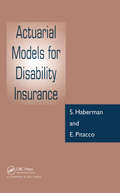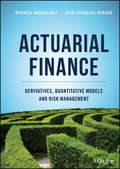- Table View
- List View
Additive Combinatorics: A Menu of Research Problems (Discrete Mathematics and Its Applications)
by Bela BajnokAdditive Combinatorics: A Menu of Research Problems is the first book of its kind to provide readers with an opportunity to actively explore the relatively new field of additive combinatorics. The author has written the book specifically for students of any background and proficiency level, from beginners to advanced researchers. It features an extensive menu of research projects that are challenging and engaging at many different levels. The questions are new and unsolved, incrementally attainable, and designed to be approachable with various methods.
Additive Combinatorics
by Terence Tao Van H. VuAdditive combinatorics is the theory of counting additive structures in sets. This theory has seen exciting developments and dramatic changes in direction in recent years thanks to its connections with areas such as number theory, ergodic theory and graph theory. This graduate-level 2006 text will allow students and researchers easy entry into this fascinating field. Here, the authors bring together in a self-contained and systematic manner the many different tools and ideas that are used in the modern theory, presenting them in an accessible, coherent, and intuitively clear manner, and providing immediate applications to problems in additive combinatorics. The power of these tools is well demonstrated in the presentation of recent advances such as Szemerédi's theorem on arithmetic progressions, the Kakeya conjecture and Erdos distance problems, and the developing field of sum-product estimates. The text is supplemented by a large number of exercises and new results.
Addition Made Easy (Making Math Easy)
by Rebecca Wingard-Nelson Tom LaBaffAre you having trouble with two-digit addition? How about three-digit addition? Does column addition confuse you? Do you wish someone could simply explain the properties of addition? Well, ask no more! In a simple and direct style, Rebecca Wingard-Nelson covers topics such as partial sums, regrouping, and place value. Whether you are learning this information for the first time—on your own or with a tutor—or you would like to review your math skills, this book will be a great choice.
Addition Facts that Stick: Help Your Child Master the Addition Facts for Good in Just Six Weeks
by Kate Snow Debra Pearson Corrin BrewerThe fun, engaging program that will help your child master the addition facts once and for all—without spending hours and hours drilling flash cards! Addition Facts That Stick will guide you, step-by- step, as you teach your child to understand and memorize the addition facts, from 1 + 1 through 9 + 9. Hands-on activities, fun games your child will love, and simple practice pages help young students remember the addition facts for good. In 15 minutes per day (perfect for after school, or as a supplement to a homeschool math curriculum) any child can master the addition facts, gain a greater understanding of how math works, and develop greater confidence, in just six weeks! Mastery of the math facts is the foundation for all future math learning. Lay that foundation now, and make it solid, with Addition Facts That Stick!
Adding Talk To The Equation: A Self-Study Guide for Teachers and Coaches on Improving Math Discussions
by Lucy WestFor more than 20 years, Lucy West has been studying mathematical classroom discourse. She believes that teachers need to understand what their students are thinking as they grapple with rich mathematical tasks and that the best way to do so is through talking and listening. In this video-rich edition of Adding Talk to the Equation: Discussions and Discovery in Mathematics, she invites teachers into real-life classrooms where all students stay in the game, stay motivated about learning, and ultimately deepen their understanding. Designed for math teachers and coaches in grades 18, this self-study guide showcases elementary and middle school classrooms where teachers inspire even the most reluctant students to share their ideas. Through the stories of skilled teachers, West offers play-by-play commentary as they get more comfortable with new talk moves and learn to tune in and respond to students' math conversations. Although these discussions occur in math class, the strategies can be used to create a respectful, productive environment for any subject area. This video-based resource examines the importance of creating a safe learning environment; the value of thinking, reasoning, and questioning; the role of active, accountable listening; and the necessity of giving all students a you can do this message. West also emphasizes that slowing down, even in the face of time constraints, is crucial for creating a classroom where all students feel they have something to contribute. This guide includes transcripts of the case studies, with insightful commentary from West that gives you a window into her thinking and the complexities of the work she is doing with teachers, as well as her reflections on missed opportunities.
Adding Latin America to the Global Projection Model
by Jorge Canales Kriljenko Charles Freedman Roberto Garcia-Saltos Marianne Johnson Douglas LaxtonAdding Latin America to the Global Projection Model
Adding+ Itup: Helping Children Learn Mathematics
by Mathematics Learning Study CommitteeAdding it Up explores how students in pre-K through 8th grade learn mathematics and recommends how teaching, curricula, and teacher education should change to improve mathematics learning during these critical years.The committee identifies five interdependent components of mathematical proficiency and describes how students develop this proficiency. With examples and illustrations, the book presents a portrait of mathematics learning: Research findings on what children know about numbers by the time they arrive in pre-K and the implications for mathematics instruction. Details on the processes by which students acquire mathematical proficiency with whole numbers, rational numbers, and integers, as well as beginning algebra, geometry, measurement, and probability and statistics.The committee discusses what is known from research about teaching for mathematics proficiency, focusing on the interactions between teachers and students around educational materials and how teachers develop proficiency in teaching mathematics.
Adaptive Survey Design (Chapman & Hall/CRC Statistics in the Social and Behavioral Sciences)
by Barry Schouten Andy Peytchev James WagnerAdaptive survey designs (ASDs) provide a framework for data-driven tailoring of data collection procedures to different sample members, often for cost and bias reduction. People vary in how likely they are to respond and in how they respond. This variation leads to opportunities to selectively deploy design features in order to control both nonresponse and measurement errors. ASD aims at the optimal matching of design features and the characteristics of respondents given the survey budget. Such a goal is sensible, but ASD requires investment in more advanced technical systems and management infrastructure and asks for the collection of relevant auxiliary data. So what are current best practices in ASD? And is ASD worthwhile when the same auxiliary data are employed in the estimation afterwards? In this book, the authors provide answers to these questions, and much more.
Adaptive Regression for Modeling Nonlinear Relationships (Statistics for Biology and Health)
by George J. Knafl Kai DingThis book presents methods for investigating whether relationships are linear or nonlinear and for adaptively fitting appropriate models when they are nonlinear. Data analysts will learn how to incorporate nonlinearity in one or more predictor variables into regression models for different types of outcome variables. Such nonlinear dependence is often not considered in applied research, yet nonlinear relationships are common and so need to be addressed. A standard linear analysis can produce misleading conclusions, while a nonlinear analysis can provide novel insights into data, not otherwise possible. A variety of examples of the benefits of modeling nonlinear relationships are presented throughout the book. Methods are covered using what are called fractional polynomials based on real-valued power transformations of primary predictor variables combined with model selection based on likelihood cross-validation. The book covers how to formulate and conduct such adaptive fractional polynomial modeling in the standard, logistic, and Poisson regression contexts with continuous, discrete, and counts outcomes, respectively, either univariate or multivariate. The book also provides a comparison of adaptive modeling to generalized additive modeling (GAM) and multiple adaptive regression splines (MARS) for univariate outcomes. The authors have created customized SAS macros for use in conducting adaptive regression modeling. These macros and code for conducting the analyses discussed in the book are available through the first author's website and online via the book s Springer website. Detailed descriptions of how to use these macros and interpret their output appear throughout the book. These methods can be implemented using other programs. "
Adaptive Filtering Under Minimum Mean p-Power Error Criterion
by Badong Chen Wentao MaAdaptive filtering still receives attention in engineering as the use of the adaptive filter provides improved performance over the use of a fixed filter under the time-varying and unknown statistics environments. This application evolved communications, signal processing, seismology, mechanical design, and control engineering. The most popular optimization criterion in adaptive filtering is the well-known minimum mean square error (MMSE) criterion, which is, however, only optimal when the signals involved are Gaussian-distributed. Therefore, many "optimal solutions" under MMSE are not optimal. As an extension of the traditional MMSE, the minimum mean p-power error (MMPE) criterion has shown superior performance in many applications of adaptive filtering. This book aims to provide a comprehensive introduction of the MMPE and related adaptive filtering algorithms, which will become an important reference for researchers and practitioners in this application area. The book is geared to senior undergraduates with a basic understanding of linear algebra and statistics, graduate students, or practitioners with experience in adaptive signal processing.Key Features: Provides a systematic description of the MMPE criterion. Many adaptive filtering algorithms under MMPE, including linear and nonlinear filters, will be introduced. Extensive illustrative examples are included to demonstrate the results.
Adaptive Filtering: Fundamentals of Least Mean Squares with MATLAB® (Electrical Engineering Primer Ser.)
by Alexander D. PoularikasAdaptive filters are used in many diverse applications, appearing in everything from military instruments to cellphones and home appliances. Adaptive Filtering: Fundamentals of Least Mean Squares with MATLAB® covers the core concepts of this important field, focusing on a vital part of the statistical signal processing area—the least mean square (LMS) adaptive filter. This largely self-contained text: Discusses random variables, stochastic processes, vectors, matrices, determinants, discrete random signals, and probability distributions Explains how to find the eigenvalues and eigenvectors of a matrix and the properties of the error surfaces Explores the Wiener filter and its practical uses, details the steepest descent method, and develops the Newton’s algorithm Addresses the basics of the LMS adaptive filter algorithm, considers LMS adaptive filter variants, and provides numerous examples Delivers a concise introduction to MATLAB®, supplying problems, computer experiments, and more than 110 functions and script files Featuring robust appendices complete with mathematical tables and formulas, Adaptive Filtering: Fundamentals of Least Mean Squares with MATLAB® clearly describes the key principles of adaptive filtering and effectively demonstrates how to apply them to solve real-world problems.
Adaptive Dynamic Programming with Applications in Optimal Control (Advances in Industrial Control)
by Ding Wang Derong Liu Qinglai Wei Xiong Yang Hongliang LiThis book covers the most recent developments in adaptive dynamic programming (ADP). The text begins with a thorough background review of ADP making sure that readers are sufficiently familiar with the fundamentals. In the core of the book, the authors address first discrete- and then continuous-time systems. Coverage of discrete-time systems starts with a more general form of value iteration to demonstrate its convergence, optimality, and stability with complete and thorough theoretical analysis. A more realistic form of value iteration is studied where value function approximations are assumed to have finite errors. Adaptive Dynamic Programming also details another avenue of the ADP approach: policy iteration. Both basic and generalized forms of policy-iteration-based ADP are studied with complete and thorough theoretical analysis in terms of convergence, optimality, stability, and error bounds. Among continuous-time systems, the control of affine and nonaffine nonlinear systems is studied using the ADP approach which is then extended to other branches of control theory including decentralized control, robust and guaranteed cost control, and game theory. In the last part of the book the real-world significance of ADP theory is presented, focusing on three application examples developed from the authors' work: * renewable energy scheduling for smart power grids; * coal gasification processes; and * water-gas shift reactions. Researchers studying intelligent control methods and practitioners looking to apply them in the chemical-process and power-supply industries will find much to interest them in this thorough treatment of an advanced approach to control.
Adaptive Dynamic Programming for Control: Algorithms and Stability (Communications and Control Engineering)
by Yanhong Luo Huaguang Zhang Ding Wang Derong LiuThere are many methods of stable controller design for nonlinear systems. In seeking to go beyond the minimum requirement of stability, Adaptive Dynamic Programming in Discrete Time approaches the challenging topic of optimal control for nonlinear systems using the tools of adaptive dynamic programming (ADP). The range of systems treated is extensive; affine, switched, singularly perturbed and time-delay nonlinear systems are discussed as are the uses of neural networks and techniques of value and policy iteration. The text features three main aspects of ADP in which the methods proposed for stabilization and for tracking and games benefit from the incorporation of optimal control methods: * infinite-horizon control for which the difficulty of solving partial differential Hamilton-Jacobi-Bellman equations directly is overcome, and proof provided that the iterative value function updating sequence converges to the infimum of all the value functions obtained by admissible control law sequences; * finite-horizon control, implemented in discrete-time nonlinear systems showing the reader how to obtain suboptimal control solutions within a fixed number of control steps and with results more easily applied in real systems than those usually gained from infinite-horizon control; * nonlinear games for which a pair of mixed optimal policies are derived for solving games both when the saddle point does not exist, and, when it does, avoiding the existence conditions of the saddle point. Non-zero-sum games are studied in the context of a single network scheme in which policies are obtained guaranteeing system stability and minimizing the individual performance function yielding a Nash equilibrium. In order to make the coverage suitable for the student as well as for the expert reader, Adaptive Dynamic Programming in Discrete Time: * establishes the fundamental theory involved clearly with each chapter devoted to a clearly identifiable control paradigm; * demonstrates convergence proofs of the ADP algorithms to deepen understanding of the derivation of stability and convergence with the iterative computational methods used; and * shows how ADP methods can be put to use both in simulation and in real applications. This text will be of considerable interest to researchers interested in optimal control and its applications in operations research, applied mathematics computational intelligence and engineering. Graduate students working in control and operations research will also find the ideas presented here to be a source of powerful methods for furthering their study.
Adaptive Critic Control with Robust Stabilization for Uncertain Nonlinear Systems (Studies in Systems, Decision and Control #167)
by Ding Wang Chaoxu MuThis book reports on the latest advances in adaptive critic control with robust stabilization for uncertain nonlinear systems. Covering the core theory, novel methods, and a number of typical industrial applications related to the robust adaptive critic control field, it develops a comprehensive framework of robust adaptive strategies, including theoretical analysis, algorithm design, simulation verification, and experimental results. As such, it is of interest to university researchers, graduate students, and engineers in the fields of automation, computer science, and electrical engineering wishing to learn about the fundamental principles, methods, algorithms, and applications in the field of robust adaptive critic control. In addition, it promotes the development of robust adaptive critic control approaches, and the construction of higher-level intelligent systems.
Adaptive Backstepping Control of Uncertain Systems with Actuator Failures, Subsystem Interactions, and Nonsmooth Nonlinearities
by Wei Wang Changyun Wen Jing ZhouIn practice, actuators often undergo failures and various factors influence its effectiveness. Also due to the increasing complexity of large-scale systems, subsystems are often interconnected, whereas the interactions between any two subsystems are difficult to deal with. This book details a series of new methodologies of designing and analyzing adaptive backstepping control systems involving treatment on actuator failures, subsystem interactions and nonsmooth nonlinearities. Moreover, it discusses some interesting open issues in adaptive failure accommodation, decentralized adaptive control and distributed adaptive coordinated control.
Adapting Interactive Learning Environments to Student Competences: The Case for Complex Dynamic Systems (SpringerBriefs in Educational Communications and Technology)
by Aklilu Tilahun Tadesse Pål Ingebright Davidsen Erling MoxnesThis monograph focuses on the design of personalized and adaptive online interactive learning environment (OILE) to enhance students’ learning in and about complex dynamic systems (CDS). Numerous studies show that students experience difficulties when learning in and about CDS. The difficulties are due to challenges originating from a) the structural complexity of CDS, (b) the production of dynamic behavior from the underlying systems structure, and (c) methods, techniques and tools employed in the analysis of such systems. Despite the fact that studies have uncovered such learning challenges, it is still not well understood how we may effectively address these challenges. In this monograph, the authors provide some answers as to how we may best improve our cognitive capabilities to meet these challenges by way of effective instructional methods, techniques, and tools and their implementation in the form of an OILE. The OILE developed for this purpose, builds on a five-step holistic instructional design framework; identification of instructional design models, identification of authentic learning material, identification of instructional methods, identification of instructional techniques, and design of the interface and implementation of the tool. In this OILE development, six well-documented instructional design models were considered; a four component instructional design, first principles of instruction, constructivists learning environment, task centered instruction, cognitive apprenticeship, and elaboration theory.
Adapting and Extending Secondary Mathematics Activities: New Tasks FOr Old
by Pat Perks Stephanie PrestageThis book is designed to assist teachers to get the most out of the textbooks or mathematics schemes used in their schools, providing methods of extending the activities offered to learners.
Adaptations for Saxon Math Student Reference Guide Intermediate 3-5
by Pat WrigleyNIMAC-sourced textbook
Ada Twist, Scientist
by Andrea Beaty David RobertsLike her classmates, builder Iggy and inventor Rosie, scientist Ada, a character of color, has a boundless imagination and has always been hopelessly curious. Why are there pointy things stuck to a rose? Why are there hairs growing inside your nose? When her house fills with a horrific, toe-curling smell, Ada knows it’s up to her to find the source. What would you do with a problem like this? Not afraid of failure, Ada embarks on a fact-finding mission and conducts scientific experiments, all in the name of discovery. But, this time, her experiments lead to even more stink and get her into trouble! Inspired by real-life makers such as Ada Lovelace and Marie Curie, Ada Twist, Scientist champions girl power and women scientists, and brings welcome diversity to picture books about girls in science. Touching on themes of never giving up and problem solving, Ada comes to learn that her questions might not always lead to answers, but rather to more questions. She may never find the source of the stink, but with a supportive family and the space to figure it out, she’ll be able to feed her curiosity in the ways a young scientist should.
Ad Hoc Networks: A Statistical Perspective
by Paramartha Dutta Amlan Chakrabarti Jyoti Prakash SinghThis book identifies the time-dependent network parameters: neighbour count, link load, path length, cluster count and delay, and presents a first-of-its-kind discussion on temporal parameters in mobile ad hoc networks. Frequent topology changes and multiple link failures occur in mobile ad hoc network due to arbitrary and random movement of nodes. <P><P>This dynamic environment challenges the delivery of data and makes it essential to find better models for network parameters that are shifting with time. The parameters identified are put into the framework of time series because of their temporal characteristic, and when they are modelled using time series framework they exhibit a sound fit with Autoregressive AR(p) models of order p. <P>The order p is evaluated for each fitted model and found to lie between one and three. The book also analyses the dependence of end-to-end delay of ad hoc network on various external factors such as the number of nodes, routing protocol, mobility models and path length and develops two prediction models. The book will be useful for researchers and professionals alike.
Actuarial Sciences and Quantitative Finance: ICASQF2016, Cartagena, Colombia, June 2016 (Springer Proceedings in Mathematics & Statistics #214)
by Jaime A. Londoño José Garrido Monique JeanblancDeveloped from the Second International Congress on Actuarial Science and Quantitative Finance, this volume showcases the latest progress in all theoretical and empirical aspects of actuarial science and quantitative finance. Held at the Universidad de Cartagena in Cartegena, Colombia in June 2016, the conference emphasized relations between industry and academia and provided a platform for practitioners to discuss problems arising from the financial and insurance industries in the Andean and Caribbean regions. Based on invited lectures as well as carefully selected papers, these proceedings address topics such as statistical techniques in finance and actuarial science, portfolio management, risk theory, derivative valuation and economics of insurance.
Actuarial Models for Disability Insurance
by S Haberman E PitaccoDisability insurance, long-term care insurance, and critical illness cover are becoming increasingly important in developed countries as the problems of demographic aging come to the fore. The private sector insurance industry is providing solutions to problems resulting from these pressures and other demands of better educated and more prosperous
Actuarial Finance: Derivatives, Quantitative Models and Risk Management
by Mathieu Boudreault Jean-François RenaudA new textbook offering a comprehensive introduction to models and techniques for the emerging field of actuarial Finance Drs. Boudreault and Renaud answer the need for a clear, application-oriented guide to the growing field of actuarial finance with this volume, which focuses on the mathematical models and techniques used in actuarial finance for the pricing and hedging of actuarial liabilities exposed to financial markets and other contingencies. With roots in modern financial mathematics, actuarial finance presents unique challenges due to the long-term nature of insurance liabilities, the presence of mortality or other contingencies and the structure and regulations of the insurance and pension markets. Motivated, designed and written for and by actuaries, this book puts actuarial applications at the forefront in addition to balancing mathematics and finance at an adequate level to actuarial undergraduates. While the classical theory of financial mathematics is discussed, the authors provide a thorough grounding in such crucial topics as recognizing embedded options in actuarial liabilities, adequately quantifying and pricing liabilities, and using derivatives and other assets to manage actuarial and financial risks. Actuarial applications are emphasized and illustrated with about 300 examples and 200 exercises. The book also comprises end-of-chapter point-form summaries to help the reader review the most important concepts. Additional topics and features include: Compares pricing in insurance and financial markets Discusses event-triggered derivatives such as weather, catastrophe and longevity derivatives and how they can be used for risk management; Introduces equity-linked insurance and annuities (EIAs, VAs), relates them to common derivatives and how to manage mortality for these products Introduces pricing and replication in incomplete markets and analyze the impact of market incompleteness on insurance and risk management; Presents immunization techniques alongside Greeks-based hedging; Covers in detail how to delta-gamma/rho/vega hedge a liability and how to rebalance periodically a hedging portfolio. This text will prove itself a firm foundation for undergraduate courses in financial mathematics or economics, actuarial mathematics or derivative markets. It is also highly applicable to current and future actuaries preparing for the exams or actuary professionals looking for a valuable addition to their reference shelf. As of 2019, the book covers significant parts of the Society of Actuaries’ Exams FM, IFM and QFI Core, and the Casualty Actuarial Society’s Exams 2 and 3F. It is assumed the reader has basic skills in calculus (differentiation and integration of functions), probability (at the level of the Society of Actuaries’ Exam P), interest theory (time value of money) and, ideally, a basic understanding of elementary stochastic processes such as random walks.
